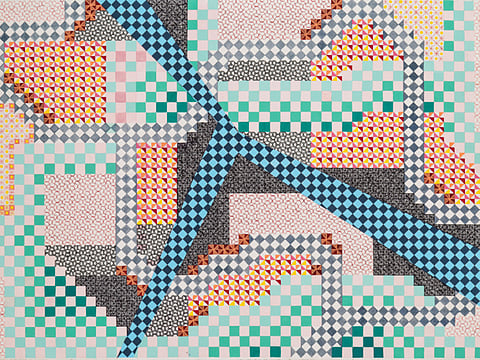Utopian urbanscapes
Iranian artist Nargess Hashemi’s latest works ‘imagine cities that are designed with architectural convenience but around the needs of the communities they are built for’

Nargess Hashemi has taken on the role of an urban planner in her latest exhibition in Dubai, I will build a tall city interconnected by cul-de-sacs. The Teheran-based artist is presenting a series of maps and crochet works that convey her utopian vision of well-planned cities and inclusive interiors designed to create a society that is more integrated, sustainable and community oriented.
“Post-modern architecture offers convenience, but it is often soulless and marginalises large groups of people mainly because it is based on standardised imported ideas that are not designed around the specific needs of a community. On the other hand, marginal communities have an environment that is not so welcoming to others. I want to imagine cities that are designed with architectural convenience but around the needs of the communities they are built for. For me cul-de-sacs or dead ends are important because these are spaces where cars cannot go and instead people can get together and green spaces can be built,” Hashemi says.
Her maps resemble contemporary satellite maps. They are based on self-created grids suggesting the artist’s desire to break free from set systems while still working within a system. Done with ink, pencil and gouache on cotton paper or canvas, the maps come with a key — telling viewers what each colour, geometric shape, and texture on the grids represents.
Hashemi’s imaginary cities have plenty of green spaces, open empty areas and water features and they are powered by solar energy and other renewable energy sources. The residential complexes are well connected by high tech transportation services and designed to cater to the needs of the communities in terms of medical services, educational institutions, cultural centres, leisure facilities and proximity to workplace. Most importantly, instead of too many roads and highways cutting across the neighbourhoods, there are long cul-de-sacs that connect them, reducing traffic pollution and encouraging people to meet and interact. She has made it a point to indicate that culturally diverse people live next to each other in the housing complexes.
The colourful maps show satellite views of her cities from different distances. Many of them highlight housing, work and leisure complexes that she has earmarked for various marginalised communities ensuring that they are well integrated in society. For instance, a series of maps representing satellite views from 500 m show small towns and large housing complexes for Craftspeople and the Research of Handicraft, Plastic Waste Collectors, and for the Rehabilitation of Immigrants; a Cultural City for the Less Privileged and a Leisure Centre for Salt Factory Workers.
Mixed populations
Other maps present satellite views from 100 m of smaller groups and services such as a Criminal Rehabilitation Centre Focused on Ecological Studies, Temporary Residence for War Refugees, and Housing Complex for Builders of the Mathematics City. A third set of maps zooms out to 5km offering an overview of large cities with mixed populations such as a Sustainable City for Porters and a City Built for Marine Conservation Activities and Employees.
“The idea is to provide every community with access to all the services they need so that they can have a good work life balance and feel well integrated with society. For example, The Marine City is designed to provide everybody involved in the marine industry, from fishermen to farmers and researchers the same quality of life. All the services they need are available in one place to create a more sustainable and practical environment for living and working,” Hashemi says.
While the maps outline how good design can lead to an integrated, equal society, Hashesmi’s crochet works made from yarn and fabric invite viewers to step inside the individual homes represented by tiny black squares on the maps. The web-like artworks, from a series titled Breathing House were handmade by a community of women comprising the artist’s family and friends.
They are stretched like walls across the gallery space to form small enclosures, hung like curtains from the ceiling and draped on a shopping trolley. Everyday objects such as plastic water bottles have been integrated into the beautiful designs. While these artworks convey Hashemi’s vision of interiors that bring communities together, the way they play with visibility and invisibility is also a subtle reference to the marginalisation of women in society.
“I see these crochet pieces as delicate partitions that separate two spaces but still keep them connected. Just like the cul-de-sacs become meeting points for communities in my reimagined cities, these crochet walls and curtains bring back the idea of community inside living spaces of the future because they allow for privacy without isolating people. I call them Breathing House because they prevent people from suffocating in closed, cramped, lonely spaces. The concept is embodied by the fact that these porous walls have been created as a community activity using everyday materials. The isolation and marginalisation of people in urban areas is a global problem, so I deliberately chose the traditional craft of crochet for these works because people around the globe can relate with it,” Hashemi says.
Jyoti Kalsi is an arts-enthusiast based in Dubai.
I will build a tall city interconnected by cul-de-sacs will run at Gallery Isabelle Van den Eynde, Alserkal Avenue, Al Quoz, until July 26.
Sign up for the Daily Briefing
Get the latest news and updates straight to your inbox



